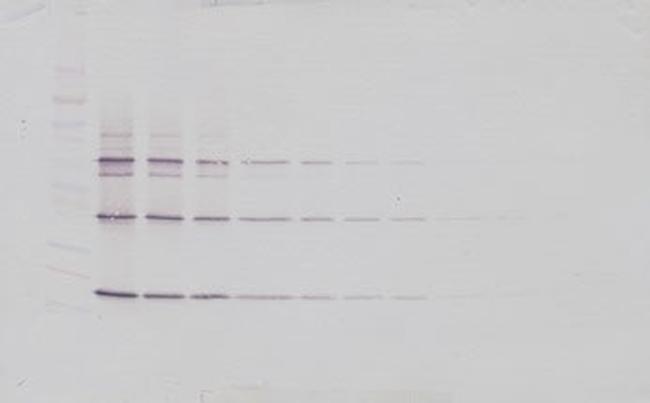Search Thermo Fisher Scientific
FIGURE: 1 / 3
TRAIL (soluble) Antibody (500-P135BT-25UG) in WB



Product Details
500-P135BT-25UG
Species Reactivity
Published species
Host/Isotype
Class
Type
Immunogen
Conjugate
Form
Concentration
Purification
Storage buffer
Contains
Storage conditions
Shipping conditions
RRID
Product Specific Information
AA Sequence of recombinant protein: MRERGPQRVA AHITGTRGRS NTLSSPNSKN EKALGRKINS WESSRSGHSF LSNLHLRNGE LVIHEKGFYY IYSQTYFRFQ EEIKENTKND KQMVQYIYKY TSYPDPILLM KSARNSCWSK DAEYGLYSIY QGGIFELKEN DRIFVSVTNE HLIDMDHEAS FFGAFLVG.
Preparation: Produced from sera of rabbits immunized with highly pure Recombinant Human sTRAIL/Apo2L. Anti-Human sTRAIL/Apo2L-specific antibody was purified by affinity chromatography and then biotinylated.
Sandwich ELISA: To detect Human sTRAIL/Apo2L by sandwich ELISA (using 100 µL/well antibody solution) a concentration of 0.25-1.0 µg/mL of this antibody is required. This biotinylated polyclonal antibody, in conjunction with PeproTech Polyclonal Anti-Human sTRAIL/Apo2L (500-P135) as a capture antibody, allows the detection of at least 0.2-0.4 ng/well of Recombinant Human sTRAIL/Apo2L.
Western Blot: To detect Human sTRAIL/Apo2L by Western Blot analysis this antibody can be used at a concentration of 0.1-0.2 µg/mL. Used in conjunction with compatible secondary reagents the detection limit for Recombinant Human sTRAIL/Apo2L is 1.5-3.0 ng/lane, under either reducing or non-reducing conditions.
500-P135BT-1MG will be provided as 2 x 500 µg
Target Information
TRAIL is a cytokine that belongs to the tumor necrosis factor (TNF) ligand family. TRAIL preferentially induces apoptosis in transformed and tumor cells, but does not appear to kill normal cells although it is expressed at a significant level in most normal tissues. TRAIL binds to several members of TNF receptor superfamily including TNFRSF10A/TRAILR1, TNFRSF10B/TRAILR2, TNFRSF10C/TRAILR3, TNFRSF10D/TRAILR4, and possibly also to TNFRSF11B/OPG. The activity of this protein may be modulated by binding to the decoy receptors TNFRSF10C/TRAILR3, TNFRSF10D/TRAILR4, and TNFRSF11B/OPG that cannot induce apoptosis. The binding of TRAIL protein to its receptors has been shown to trigger the activation of MAPK8/JNK, caspase 8, and caspase 3. Receptors for TRAIL include two death domain containing receptors, death receptor 4 (DR4) and DR5, as well as two decoy receptors, DcR1 and DcR2, lacking the intracellular signaling death domain. TRAIL is a type II membrane protein and expressed in a variety of human tissues. Like TNF and Fas ligand, TRAIL induces apoptosis and NF-kB activation in many tissues and cells.
For Research Use Only. Not for use in diagnostic procedures. Not for resale without express authorization.
Bioinformatics
Protein Aliases: Apo-2 ligand; Apo-2L; CD253; CD253 antigen; chemokine tumor necrosis factor ligand superfamily member 10; Protein TRAIL; TNF superfamily member 10; TNF-related apoptosis inducing ligand TRAIL; TNF-related apoptosis-inducing ligand; TRAIL protein; tumor necrosis factor (ligand) family, member 10; tumor necrosis factor (ligand) superfamily member 10; tumor necrosis factor (ligand) superfamily, member 10; tumor necrosis factor apoptosis-inducing ligand splice variant delta; tumor necrosis factor ligand 6A; Tumor necrosis factor ligand superfamily member 10
Gene Aliases: Apo-2L; APO2L; CD253; TL2; TNFSF10; TNLG6A; TRAIL
UniProt ID: (Human) P50591
Entrez Gene ID: (Human) 8743

Performance Guarantee
If an Invitrogen™ antibody doesn't perform as described on our website or datasheet,we'll replace the product at no cost to you, or provide you with a credit for a future purchase.*
Learn more
We're here to help
Get expert recommendations for common problems or connect directly with an on staff expert for technical assistance related to applications, equipment and general product use.
Contact tech support
